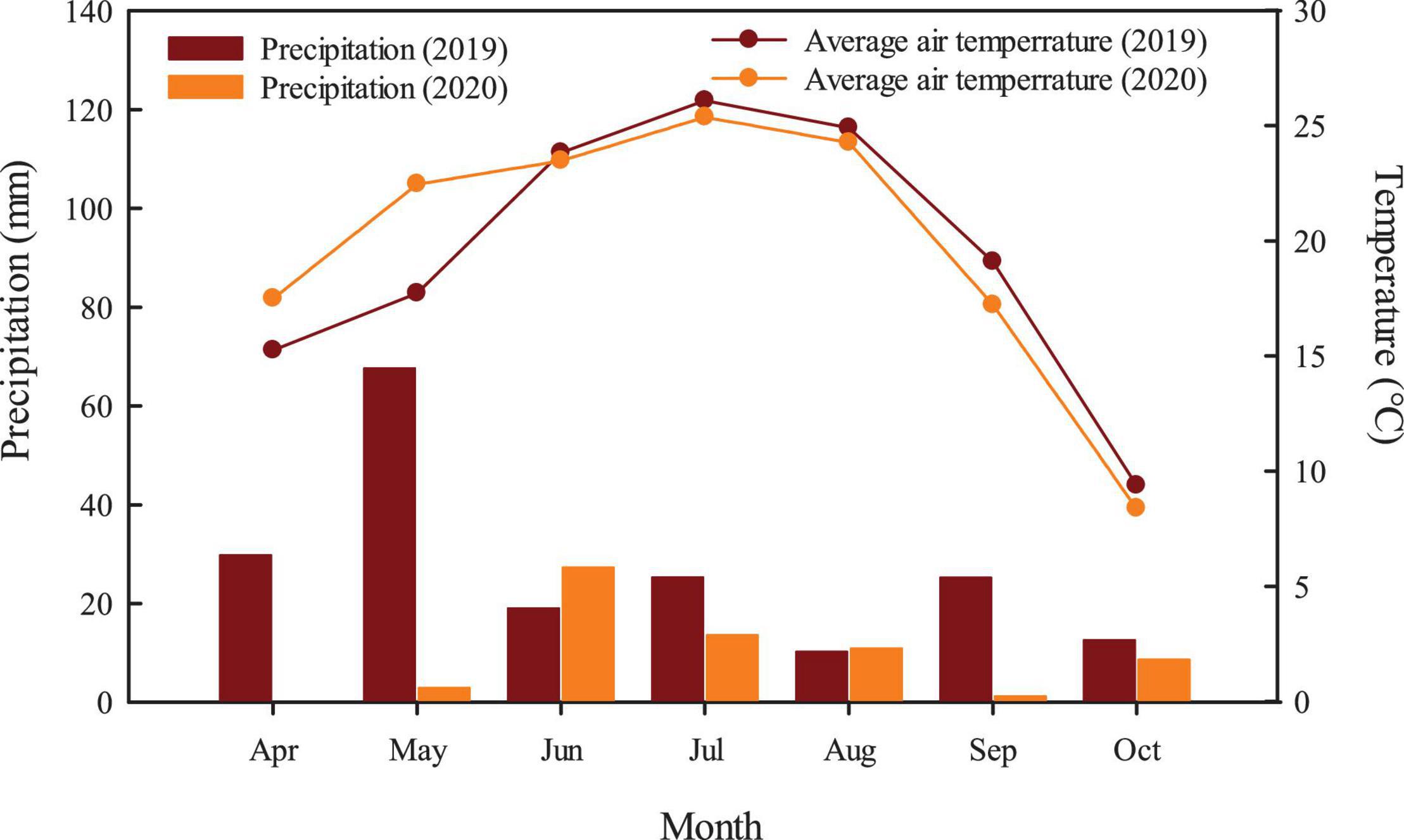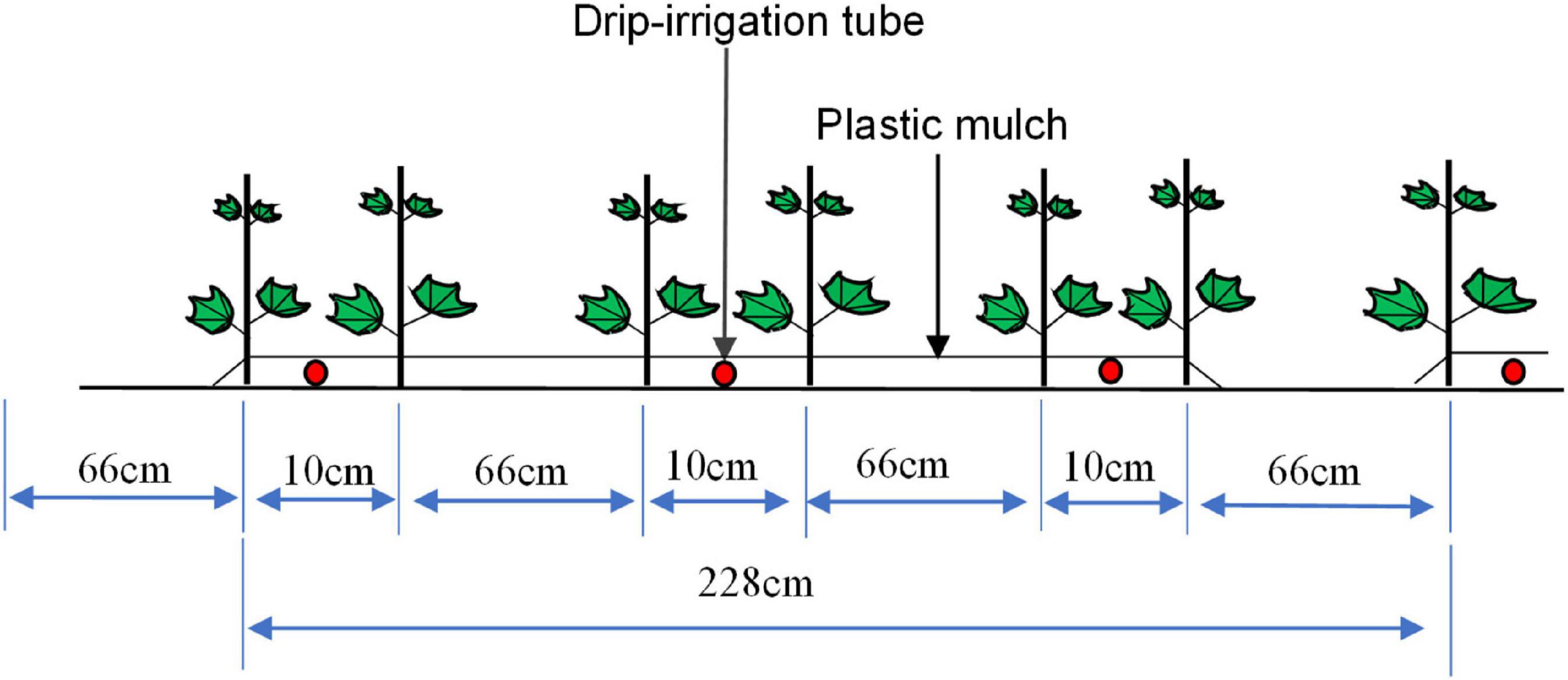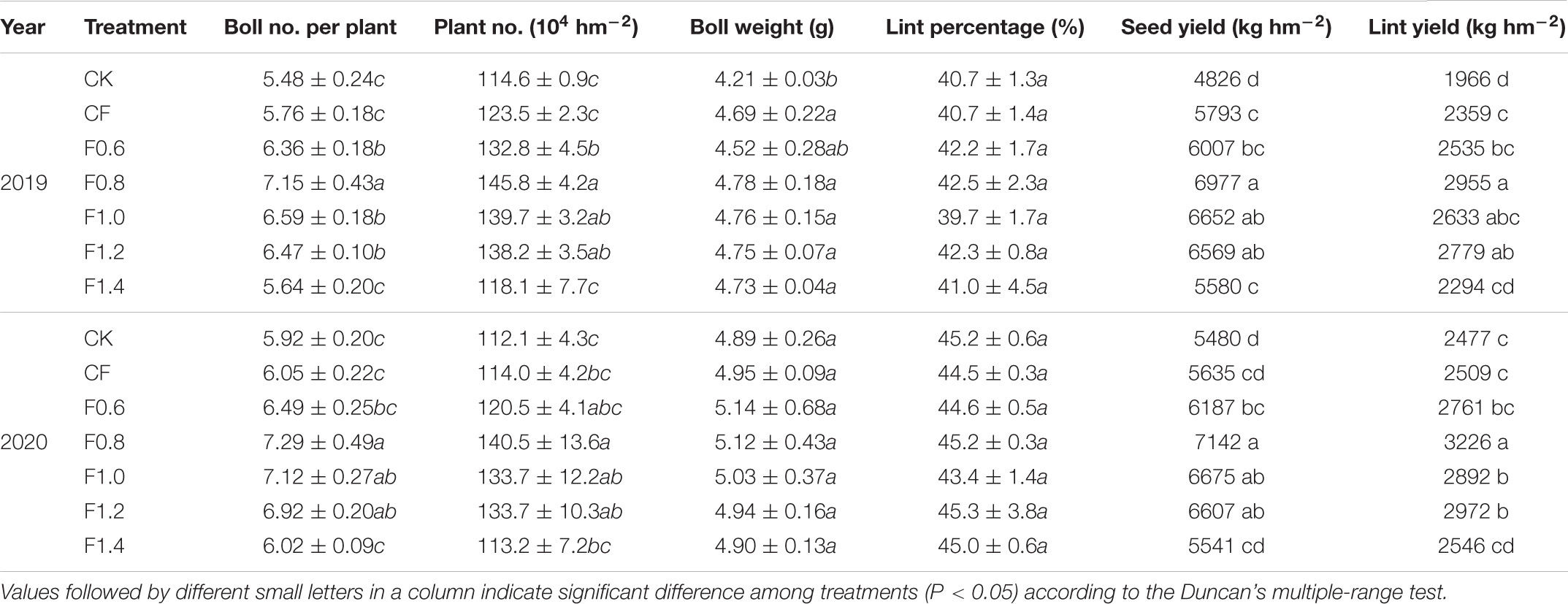- 1The Key Laboratory of Oasis Eco-Agriculture, Xinjiang Production and Construction Group, Shihezi University, Shihezi, China
- 2Xinjiang Academy Agricultural and Reclamation Science, Shihezi, China
Excessive fertilization, low nutrient utilization rate, and continuous deterioration of cotton field environment have adversely affected the sustainable development of cotton in Xinjiang province of China. To overcome these issues, we hypothesized that an appropriate combination of liquid organic fertilizer and chemical fertilizer (CF) would effectively reduce the input of CF without sacrificing the quality and yield of cotton. A 2-year field experiment explores the effects of three fertilization treatments on the growth, biomass accumulation, and yield of cotton. The three fertilization treatments, namely, no application of fertilizer (CK), the single application of CF, and the combined application of organic liquid fertilizer and CF (F0.6–F1.4), were set up in five ratios. Compared with CF treatment, the combined application of organic liquid fertilizer and CF treatments (F0.6–F1.2) speeded the growth period of cotton by 2–7 days with increased plant height, stem diameter, functional leaf width, and more number of branches, with 9.7–23.5 and 8.4–28.5% higher total plant biomass (TPB) and reproductive organs biomass (ROB), respectively. Compared with CF treatment, the rapid growth duration and maximum accumulation rate of reproductive organs were the highest in F0.8 treatment, with an average increase of 4.6 days and 20.3%. Increment in biomass accumulation contributed to an average increase of 21.8 and 18.9% in cotton boll number and yield, respectively, under F0.8 treatment. Principal component analysis shows that the total biomass, ROB, and total bolls per unit area were positively correlated with the yield, while stem diameter and vegetative organ biomass are negatively correlated with the yield. In conclusion, under film mulching with drip irrigation, organic liquid fertilizer combined with CF reduced by 20% (F0.8 treatment: N, P2O5, and K2O were 182, 104, and 76 kg hm–2, respectively) can sustain the normal growth, promote the accumulation rate of ROB, and lead to efficient cotton production.
Introduction
China had a 25.6% of the cotton production worldwide in 2020, and its seeded area was 10.1% of the total world (Arshad et al., 2021). Xinjiang, being a high-quality cotton production area in China, had 25,019 km2 of cotton planting area, accounting for 78.9% of the total in the country. The total cotton output reached 5.161 million tons, accounting for 87.3% of the national total output and 22.3% of the global total cotton output (National Bureau of Statistics, 2020). Xinjiang has become an important region that affects the world cotton production pattern (Lou et al., 2021). However, with the rising labor cost, agricultural materials, and logistics, the relationship of the cost and profit of cotton production has gradually entered a stage of “high input and low output” (Li et al., 2016). The pursuit of high yield is often accompanied by the increasing input of chemical fertilizer (CF) (Dong et al., 2010). However, the problems of soil fertility degradation, greenhouse gas emission, imbalance of soil structure, and soil-borne diseases are becoming serious year by year (Li et al., 2017; Nan et al., 2019; Massey and Gedikoglu, 2021). Therefore, to ensure the efficient and sustainable development of cotton in Xinjiang, exploring a reasonable fertilization model has become one of the key challenges for cotton researchers.
Appropriate application of organic fertilizer and CF is a crucial measure to improve the fertilizer utilization rate and solve the problem of unreasonable use of CF (Han et al., 2021). It has been found that the yield of seed cotton with organic fertilizer combined with CF increases significantly (Tian et al., 2012). Also, the application of organic fertilizer could improve the composition of soil carbon pool and the transformation process and thus raise the soil quality (Zhang P. P. et al., 2019). However, the continuous increase of the replacement amount of organic fertilizer will also lead to the reduction in crop yield, which is attributed to the reduction of the accumulation and operation of dry matter and NPK nutrients during the growth period (Pei et al., 2020). Therefore, there is no definite standard for the amounts of organic fertilizer for different crops, and the standardized use of organic fertilizer is the premise of improving the quality and production efficiency of crops.
Film mulching with drip irrigation improves the utilization efficiency of water and fertilizer and is widely used in arid areas (Chen et al., 2010). It is easy to form a smaller root-to-shoot ratio through drip irrigation under mulch, which is beneficial to the distribution of photosynthetic products to reproductive organs and improves the yield of seed cotton (Wang et al., 2020). However, the traditional organic fertilizer application method has low utilization rate and poor solubility, which increases the cost and is not conducive to simplifying cotton planting (Tao et al., 2014). Our previous research found that organic liquid fertilizer can regulate cotton plant type, promote cotton boll maturity, and increase cotton yield (Ma et al., 2020). However, few reports are available on the mechanism of increased cotton production and dry matter accumulation characteristics of the combined application of organic liquid fertilizer and CF under drip irrigation with plastic film mulching. Furthermore, the amount of the combined application of organic liquid fertilizer and CF has not yet been explored.
Therefore, the purpose of this study was to explore the effects of the combined application of organic liquid fertilizer and CF on cotton growth and agronomic traits and to determine the relation of cotton growth, agronomic traits, and biomass accumulation with yield using the principal component analysis. This study also explores and finds out the best application amount of the combined application of organic liquid fertilizer and CF suitable for high and stable yield of cotton.
Materials and Methods
Experimental Site and Cultivar
The experiment was conducted at the Crop Efficient Water Use Observatory (45°38′N, 86°09′E) of the Ministry of Agriculture of Xinjiang Academy of Agricultural Sciences from 2019 to 2020. It was largely sandy loam, and the former crop of the experimental area was corn. The basic physical and chemical properties of the 0–20 cm topsoil are as follows: organic matter 15.00 g kg–1, alkali-hydrolyzable nitrogen 42.20 mg kg–1, rapid available phosphorus 19.81 mg kg–1, and rapid available potassium 274.28 mg kg–1. The tested cotton was Xinluzao 74 (Gossypium hirsutum L.), which had a growth period of 124 days and was provided by Shihezi Academy of Agricultural Sciences. The average temperature and precipitation during cotton growth period are shown in Figure 1.
Experimental Design and Management
In this study, three fertilization treatments were targeted, i.e., specific application rates of nitrogen, phosphorus, and potassium in each treatment (Table 1); no application of fertilizer (CK), the single application of CF, and the combined application of organic liquid fertilizer and CF were set up in five ratios. For CF treatment, N, P2O5, and K2O were 228, 131, and 95 kg hm–2, respectively. The F0.6–F1.4 treatments only adjusted the application of N, P2O5, and K2O, with 137, 78, and 57 kg hm–2 for the treatment F0.6 (organic liquid fertilizer combined with CF reduced by 40%); 182, 104, and 76 kg hm–2 for the treatment F0.8 (organic liquid fertilizer combined with CF reduced by 20%); 228, 131, and 95 kg hm–2 for the treatment F1.0 (organic liquid fertilizer combined with CF); 273, 157, and 114 kg hm–2 for the treatment F1.2 (organic liquid fertilizer combined with CF increased by 20%); and 319, 183, and 133 kg hm–2 for the treatment F1.4 (organic liquid fertilizer combined with CF increased by 40%), respectively. The experiment was performed in a randomized complete design with three replications. Each plot was 10 m long and 6.9 m wide.
Chemical fertilizer treatment included urea (containing N 46.0%), monoammonium phosphate (ammonium dihydrogen phosphate containing N 12.0% and P2O5 61.0%), and potassium sulfate (containing K2O 50.0%). Organic liquid fertilizer was developed by our research group, with yeast waste liquid as carrier, adding trace elements, functional microbial flora. The effective components were soluble organic matters (humic acid ≥ 30 g –1, amino acid ≥ 10 g L–1), trace elements (manganese, zinc, boron ≥ 1 g L–1), microbial flora (Bacillus subtilis ≥ 2 × 108 g–1), and pH 4.5–6.5. Cotton was grown by drip irrigation combined with the plastic film mulching technique. The film was 2.28 m wide, with six rows in each film sheet (row spacings of 10, 66, 10, 66, 10, and 66 cm; see Figure 2), sown on April 18, 2019 and April 13, 2020. The total irrigation amount was 4350 m3 hm–2, all treated fertilizers were applied topdressing under drip irrigation, and other management measures were the same as those of high-yield cotton fields, except fertilizer factors.
Data Collection
Growth Process and Agronomic Traits
Ten cotton plants with uniform growth were continuously fixed in each treatment, and the actual date of each period [bud emergence, flowering, full flowering, full boll, and boll opening (BO)] was recorded every 7 days. The plant height, number of fruit branches, width of inverted four leaves, stem diameter, and number of buds, flowers, and bolls of cotton were investigated in each growth period.
Yield and Its Components
At the harvest period (September 22, 2019 and September 26, 2020), three representative sampling points (2.93 m × 2.28 m) were selected for each treatment, and the number of plants per unit area and bolls per plant in each sampling point were investigated. Meanwhile, 50 cotton bolls were picked from the top, middle, and bottom of each plot (according to the plant height, above one-third of the height was the upper branch, two-thirds was the middle branch, and the rest was the lower branch), which were put into paper bags separately for indoor determination of lint percentage and single boll weight.
Biomass Accumulation and Distribution
Six plants were sampled at budding, full flowering, full boll, later full boll (LFB), and BO periods of cotton growth. Plants were divided into different organs, such as roots (below cotyledon knot), stems, leaves, and buds. These samples were enveloped and placed in oven at 105°C for 0.5 h. Then, the temperature was lowered to 80°C, and the plant samples were dried to constant weight and weighed to record dry weight.
A logistic equation was used to describe the process of biomass accumulation (Yang et al., 2011).
where Y (g) represents the biomass at the actual time t, K (g) denotes the maximum biomass, t (days) is the number of days after emergence (DAE), and a and b are constants.
From Eq. 1, it follows that
When t = t0, Vm (g day–1) is the maximum biomass accumulation rate in the rapid accumulation period, t0 (days) is rapid biomass accumulation period, t1 (days) is the start point of biomass rapid accumulation period, t2 (days) is the end point of biomass rapid accumulation period, Y1 (g) and Y2 (g) are the biomass accumulation on the t1-th and t2-th days, respectively, and Vt is the average biomass accumulation rate from t1 to t2.
Statistical Analysis
Microsoft Office 2010 was used for data processing. Figures were plotted using Sigmaplot 14.0 software. R 4.0.4 was used to analyze the principal component analysis, SPSS 19.0 for data variance analysis and regression analysis, and Duncan’s method for multiple comparison. The significant difference level was 0.05 (P < 0.05).
Results and Analysis
Growth Period
Cotton plant transitioned to squaring stage, flowering stage, and BO stage at 34–35, 55–62, and 114–127 days, respectively (Table 2). The growth period of cotton plant increased with the increase of organic liquid fertilizer and CF in the following trend: F1.4 > F1.2 > F1.0 > F0.8 > F0.6. Compared with CF treatment, the growth period of F1.0 treatment was 4 days earlier, mainly because the flowering and BO of the F1.0 treatment were 4 days earlier. However, compared with CF treatment, the growth period of F0.6 and F0.8 treatments was 5–8 more days earlier; squaring period, flowering, and boll setting period were shortened by 6–8 days; and the flowering and boll setting period of F1.2 and F1.4 treatments increased by 3–4 days.

Table 2. Effect of different fertilization schedules on the cotton growing stages and periods (2020).
Agronomic Traits
The height of cotton plant increases rapidly before the full flowering period and sustained later in the season (Figure 3). Plant height among different treatments increases in the following order: F1.4 > F1.2 > F1.0 > F0.8 > F0.6 > CF. The functional leaf width increases first and then decreases as the plant transitioned from one stage to another stage. The functional leaf width was higher at peak at full flowering stage under CF treatment, while the combined application of organic liquid fertilizer and CF treatments had higher at peak at full boll stage. Compared with CF treatment, combined application of organic liquid fertilizer and the increased CF increased the functional leaf width at different stages, except for F0.6 treatment. Compared with F1.0 treatment, the leaf width of F0.8 treatment was significantly higher at full flowering stage.
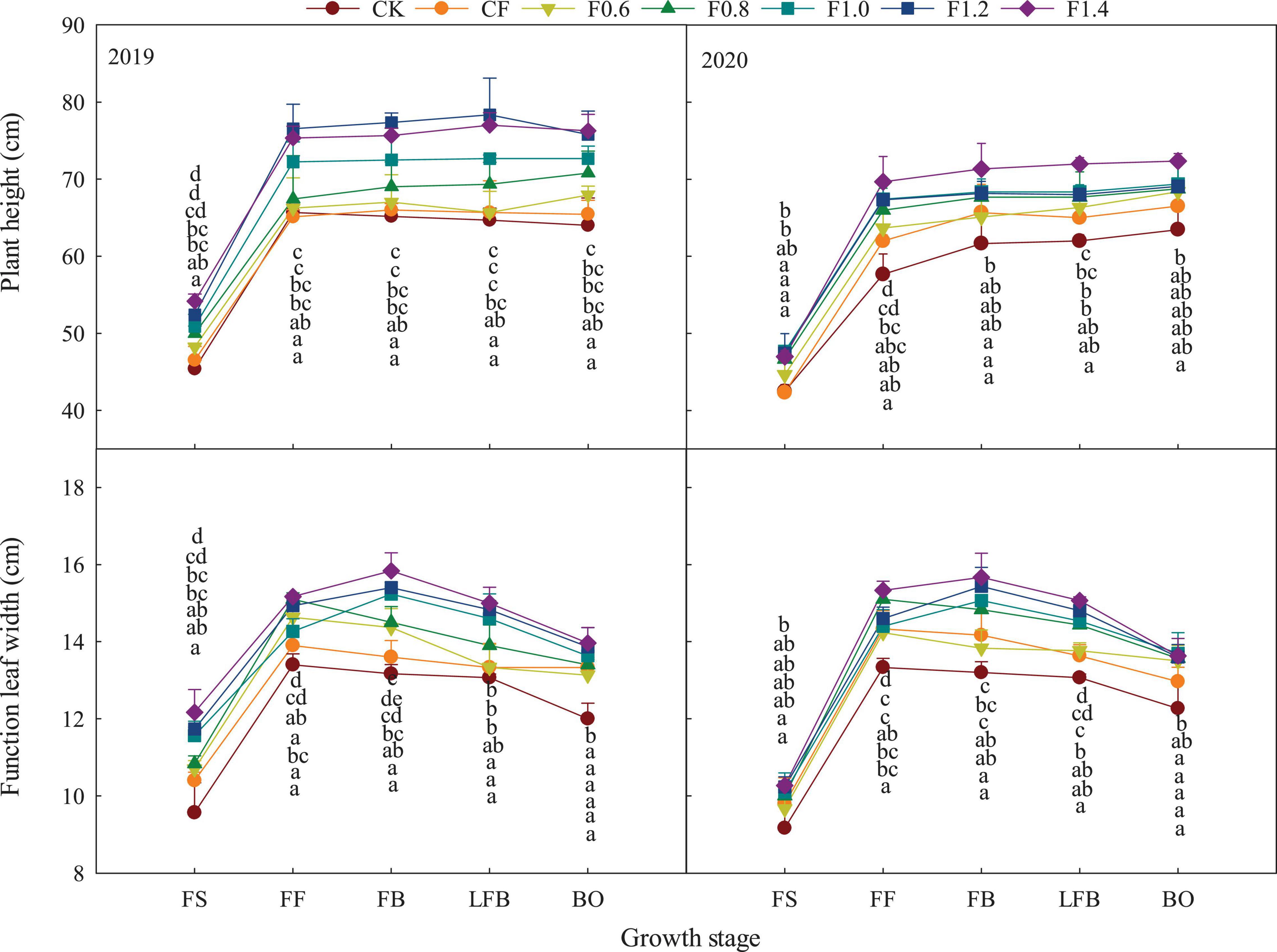
Figure 3. The changes of cotton plant height and functional leaf width in different fertilization treatments. FS, full squaring stage; FF, full flowering stage; FB, full boll stage; LFB, later full boll stage; BO, boll opening stage. Different letters above the adjacent seven columns indicate statistical significance at the P = 0.05 level.
The stem diameter of cotton plant was higher at BO period (Figure 4). Before full flowering stage, the stem diameter of fertilization treatments was significantly higher than that of CK, and there was no significant difference among fertilization treatments. After full flowering, the stem diameter of F1.0, F1.2, and F1.4 treatments was significantly higher than that of CK, CF, and F0.6 treatments.
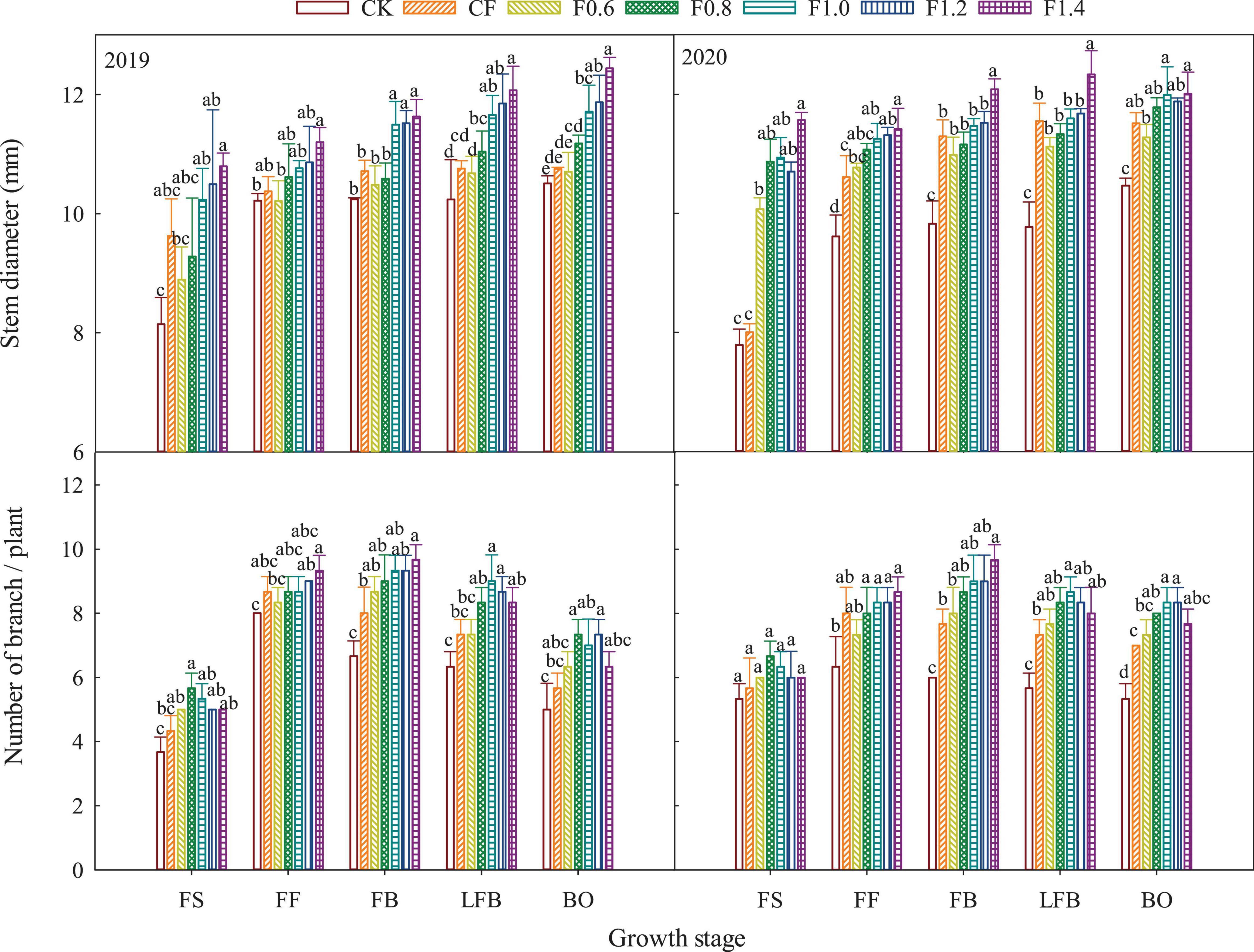
Figure 4. The changes of cotton stem diameter and cotton branches in different fertilization treatments. FS, full squaring stage; FF, full flowering stage; FB, full boll stage; LFB, later full boll stage; BO, boll opening stage. Different letters above the adjacent seven columns indicate statistical significance at the P = 0.05 level.
The number of branches of cotton plant first increased and then decreased with the growth period. Compared with CK treatment, the number of branches in different treatments increased significantly, and there was no obvious difference between F0.6 and CF treatments in the whole growth period. The number of branches in CK and CF treatments reached the peak at full flowering stage, while the combined application of organic liquid fertilizer and CF treatments had higher number at full boll stage. Compared with LFB stage, the number of effective branches of each treatment decreased at BO stage, among which the decreases of F0.8 and F1.2 treatments were small, 8.00 and 7.69%, respectively, and F1.4 treatment was the highest with 14.08%.
Biomass Accumulation
The biomass accumulation of cotton plant was significantly influenced by different fertilization treatments (Figure 5). Biomass accumulation was increased when the plant grew. Compared with CF treatment, the total plant biomass (TPB) of F0.8–F1.4 treatments was increased by 9.7–23.5% and the vegetative organ biomass (VOB) of F0.8–F1.4 treatments was increased by 8.4–28.5%, but root biomass of F1.2 and F1.4 treatments were increased by 24.1 and 12%, respectively. The reproductive organ biomass (ROB) in different treatments had no significant effect at full flowering stage. Compared with CK treatment, the average increase of ROB in fertilization treatment was 36.9%. Compared with CF treatment, the ROB of F0.8 and F0.6 treatments were increased by 20.1 and 7.0%, respectively.
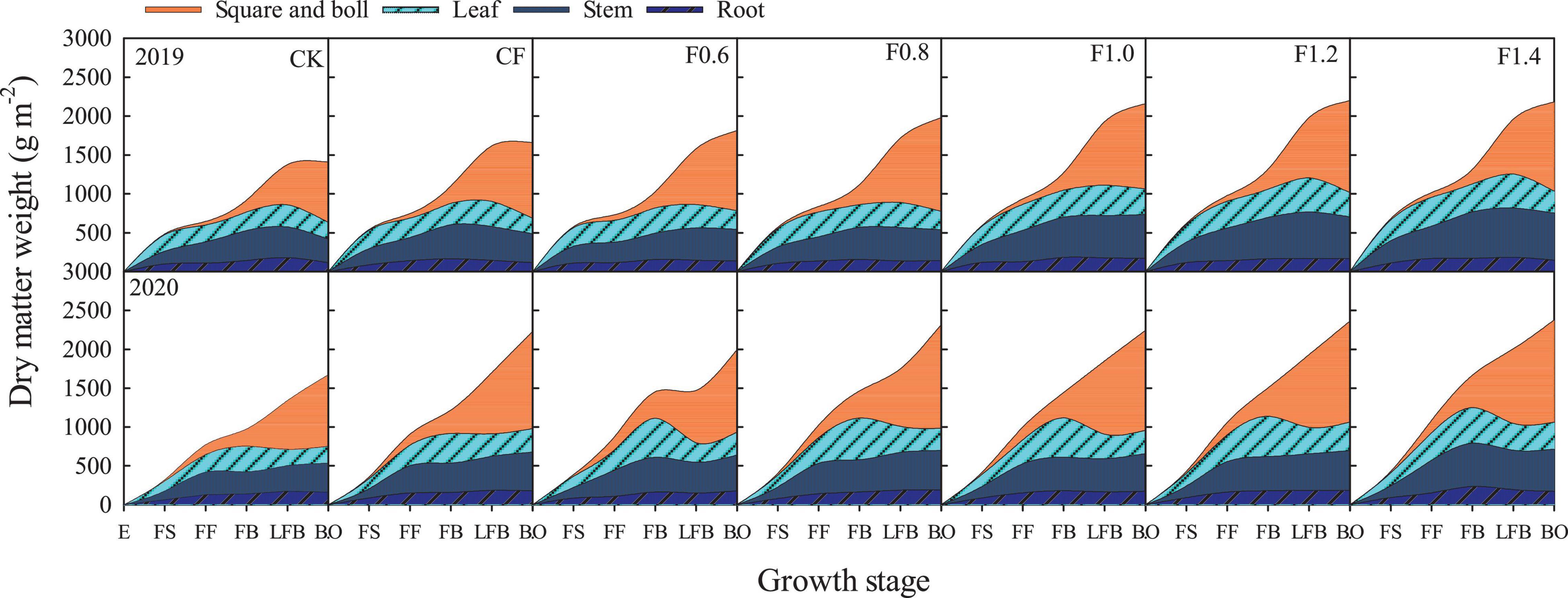
Figure 5. The change in productive organ, leaf, and stem, and root dry mass (g m–2). E, emergence; FS, full squaring stage; FF, full flowering stage; FB, full boll stage; LFB, later full boll stage; BO, boll opening stage.
Characteristics of Biomass Accumulation
Regression analysis (Table 3) shows that the accumulation of cotton biomass types in each treatment accords with logistic function. ROB was better than VOB since reproductive growth was more vigorous and the vegetative growth was inhibited after full flowering. Compared with CK treatment, the time (t1) periods when TPB and VOB entered the rapid accumulation period of cotton under fertilization treatment were 2.6 and 2 days shorter, respectively, while ROB was 0.8 days longer. The fast accumulation termination time (t2) shows that TPB and ROB in CF treatment took 1.2 more days, and VOB was shortened by 1.9 days. Under the combined application of organic liquid fertilizer and CF treatments, the termination time of TPB and ROB was delayed by 3.4 days, and VOB was greater by 0.1 day. Compared with CK treatment, the maximum and average accumulation speed (Vm and Vt) of TPB, VOB, and ROB in CF treatment increased by 31.8 and 31.3, 20.2 and 20.2, and 29.2 and 29.2%, respectively, in the rapid accumulation period (T). Vm and Vt in the combined application of organic liquid fertilizer and CF treatments increased by 46.2 and 45.7, 49.1 and 49.3, and 39.7 and 39.9%, respectively. The fast accumulation duration of biomass in different treatments was F0.6 > F0.8 > F1.4 > F1.2 > F1.0 > CF for TPB, F0.6 > CF > F1.0 > F1.2 > F1.4 > F0.8 for VOB, and F0.8 > F0.6 > F1.2 > CF > F1.4 > F1.0 for ROB. Compared with CF treatment, Vm and Vt had the largest increase in F1.4 treatment, followed by F0.8 treatment; compared with CF treatment, Vm and Vt of TPB increased by 18.6 and 18.3, 15.9 and 15.7% on average; the average increase in VOB was 45.6 and 45.5, 32.6 and 32.7%; while ROB increased by 20.3 and 20.5%.
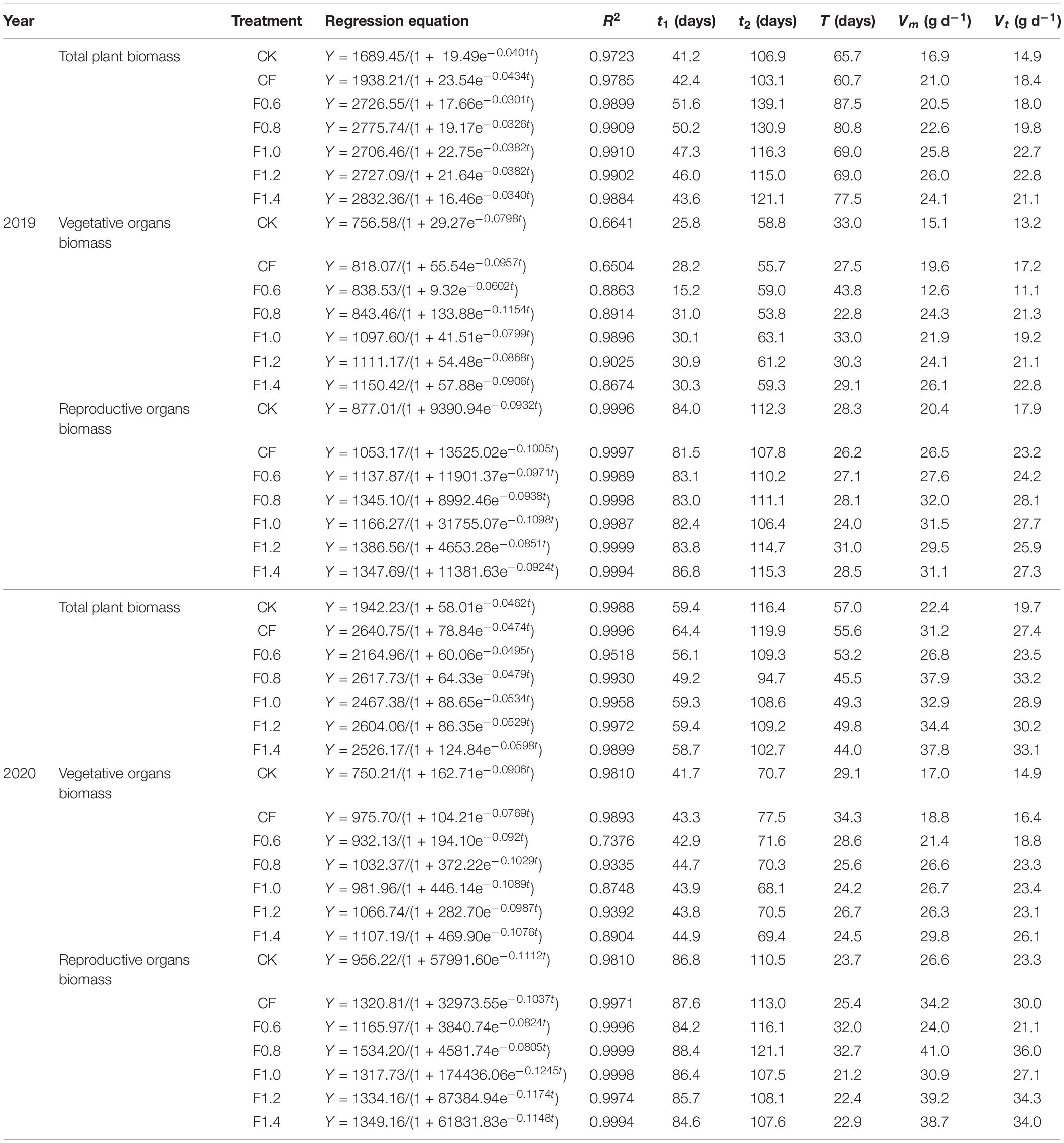
Table 3. Biomass accumulation equations of cotton in different organs and eigenvalues of cotton biomass accumulations under different fertilization treatments.
Cotton Yield and Its Components
Cotton yield and its components were substantially affected by different fertilization treatments (Table 4). The performance of seed cotton and lint yield between treatments was as follows: F0.8 > F1.0, F1.2, F0.6 > CF, F1.4. Compared with CF treatment, seed cotton was increased by 21.8, 15.0, and 13.7% for F0.8, F1.0, and F1.2 treatments, respectively. No significant differences were noted for lint percentage and single boll weight among different treatments. The number of bolls per plant and total number of bolls per unit area were increased in the following order: F0.8 > F1.0 > F1.2 > F0.6 > CF > F1.4 > CK. Compared with CF treatment, the number of bolls per plant and total number of bolls per unit area were increased by 22.4 and 18.9%, respectively, under F0.8 treatment.
Principal Component Analysis
Principal component analysis of different parameters is shown in Figure 6. Biomass accumulation, yield, and its composition, indicates that at full budding stage, the contribution rates of the first, second, and third principal components were 38.6, 31.6, and 12.9%, respectively. The cumulative contribution of the first three principal components was 83.1%, which could explain the data well and clearly distinguish between different fertilization modes in PC2. The maximum VOB in PC1 was 0.95, followed by total biomass, functional leaf width, and plant height, but negatively correlated with the number of fruit branches, weight of single boll, and ROB. The maximum load value of seed cotton yield in PC2 was 0.92, followed by the number of bolls per plant, number of fruit branches, and stem diameter. This showed that the number of fruit branches, number of bolls, and stem diameter could be increased synchronously after applying organic liquid fertilizer at full budding stage and that the smooth flow of pool expansion could help increase the yield.
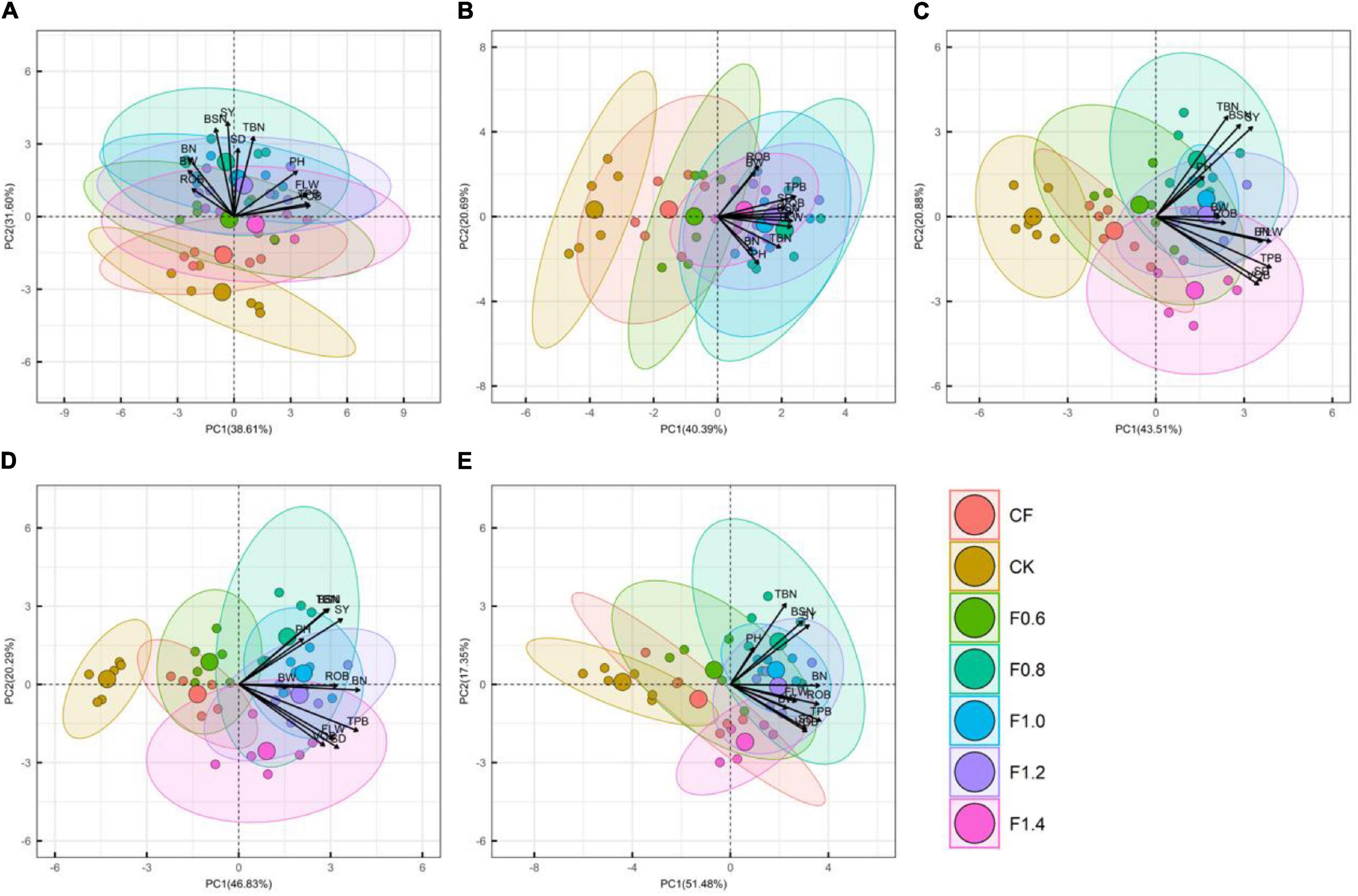
Figure 6. The principal component analysis among measured parameters (i.e., BN, BW, BSN, FLW, PH, ROB, SD, SY, TBN, TPB, and VOB) in different growth stages. The different capital letters in the picture represent different periods of fertility. (A) Full squaring stage, (B) full flowering stage, (C) full boll stage, (D) later full boll stage, and (E) boll opening stage.
The contribution rates of the first, second, third, and fourth principal components were 40.4, 20.7, 17.5, and 6.8%, respectively, and the cumulative contribution of the four principal components was 85.4%. Different fertilization modes could be clearly distinguished in PC1. The maximum load value of cotton biomass in PC1 was 0.80, followed by VOB, seed cotton yield, functional leaf width, and the number of bolls per plant. The maximum biomass load of reproductive organs of PC2 was 0.78, followed by single boll weight. The results showed that the application of organic liquid fertilizer could promote the vegetative growth of cotton.
The first, second, third, and fourth principal components contributed 43.5, 20.9, 17.1, and 6.3%, respectively, and the cumulative contribution of the four principal components was 87.7%. The maximum load value of cotton total biomass in PC1 was 0.83, and the load value of VOB was greater than that of seed cotton yield and ROB. PC2 could clearly distinguish F1.4 treatment from other treatments, and the maximum load value of total bolls per unit area in PC2 was 0.75, followed by the number of bolls per plant and seed cotton yield, while stem diameter, VOB, and total biomass were negatively correlated. The contribution rates of the first, second, third, and fourth principal components were 46.8, 20.3, 11.6, and 7.1%, respectively, and the cumulative contribution rate of the four principal components was 85.9%. The maximum load value of the number of fruit branches in PC1 was 0.87, followed by cotton total biomass, seed cotton yield, and cotton ROB. PC2 can also clearly distinguish F1.4 treatment from other treatments, and the load value of the number of bolls per plant and total number of bolls per unit area is larger. However, the yield was negatively correlated with biomass accumulation and agronomic traits. The results indicated that excessive fertilizer input in F1.4 treatment resulted in excessive growth of cotton nutrition, which was not conducive to the increase of yield.
The first, second, third, and fourth principal components contributed 51.5, 17.4, 8.9, and 8%, respectively, and the cumulative contribution rate of the four principal components was 85.7%. The maximum load value of cotton total biomass in PC1 was 0.89, followed by the number of fruit branches, ROB, and seed cotton yield. The maximum load value of total bolls per unit area in PC2 was 0.75, followed by the number of bolls per plant, seed cotton yield, and plant height.
Discussion
Organic Liquid Fertilizer Can Promote Cotton Flowering and Maturity and Regulate Cotton Growth
As one of the important agronomic characteristics, cotton growth period is affected by different fertilization treatments (Li, 2013). This study shows that the combined application of organic liquid fertilizer and CF can hasten the flowering and BO stages of cotton. Principal component analysis of the flowering stage also indicates that the combined application of organic liquid fertilizer and CF can promote the vegetative growth of cotton. Organic fertilizer and bioorganic fertilizer instead of CF could prolong the growth of cotton, and the use of more bioorganic fertilizer can result in a longer growth period (Sun et al., 2020). Sufficient nutrient supply in early growth stage can accelerates early development of cotton (Lu et al., 2017); this may be due to nitrogen from moving with water, which resulted in improved capacity of soil fertilizer supply (Li et al., 2019). Therefore, the application of organic fertilizer can enhance soil quality (Han et al., 2021) and improve soil microbial structure (Tao et al., 2020).
The related indexes of cotton plant type directly reflect the growth and development of cotton plants (Feng et al., 2016). This study finds that the combined application of organic and CF s can significantly increase plant height and stem diameter of cotton with the increase application amount, but the yield did not increase synchronously. Compared with F1.0 treatment, the plant height and stem diameter of F0.8 treatment did not decrease significantly. Organic–inorganic compound fertilizer increased soil-plant analysis development (SPAD), plant height, and tiller number of leaves (Moe et al., 2019). Nitrogen application can promote cell division and internode elongation, which may be the main reason for the increase in plant height (Sheoran et al., 2017).
The relationship between sink and source can reflect the coordination between vegetative growth and reproductive growth of cotton and affect the maturity (Chen and Dong, 2016). In this study, organic liquid fertilizer extends the time of cotton leaf width before reaching the peak. These data indicate that organic liquid fertilizer can promote cotton growth, but excessive application can lead to vigorous vegetative growth and serious shedding of lower fruit branches in the later growth stage. The reason may be that excessive application of liquid fertilizer leads to the increase in sink-to-source ratio of cotton, which accelerates leaf senescence, resulting in the increase of leaf shedding in the lower part of cotton (Chen et al., 2018). Another reason might be poor light transmittance in the lower canopy, which reduces the temperature and increases humidity, leading to shedding of buds and bolls (Khan et al., 2017).
Organic Liquid Fertilizer Prolongs the Rapid Accumulation of Dry Matter and Improves the Accumulation Rate
Dry matter is the basis of cotton yield (Mamnabi et al., 2020), and the rational distribution of photosynthetic compounds is the main factor affecting cotton yield (Zahoor et al., 2017). Replacing CF with organic fertilizer can increase the biomass accumulation of cotton (Wang S. J. et al., 2021). Compared with CF treatment, the total biomass and VOB of cotton under combined application of organic liquid fertilizer and CF showed an upward trend, and F0.8 treatment significantly increased ROB by 20.1%. This indicates that F0.8 treatment (CF reduced by 20% combined with organic liquid fertilizer) improves the transport of photosynthetic products to reproductive organs without reducing the biomass accumulation.
In this study, the combined application of organic liquid fertilizer and CF treatment increased the duration of rapid accumulation of total biomass. The F0.8 treatment had the longest duration and average rate of ROB accumulation. Excessive application of nitrogen fertilizer can hasten rapid growth period and prolong its duration, which affects the full transfer of nutrients to buds and bolls, resulting in reduction of yield (Xue et al., 2006). In this study, principal component analysis shows that there is a significant correlation between cotton biomass accumulation, growth traits, and yield. A positive correlation between cotton yield and the whole plant biomass has been reported (Luo et al., 2020).
Organic Liquid Fertilizer Can Increase Bolls Number and Yield
Combined application of organic and inorganic fertilizer can promote cotton growth and increase the number of bolls per plant (Tao et al., 2015). This study showed that cotton yield increased with the combined application of organic liquid fertilizer and CF, with the F0.8 treatment having the highest yield. The increase in yield was allied with more bolls per plant and total bolls per unit area. Grain yield increased by 5.58–18.67% after applying urea containing humic acid due to the increase in the number of grains per plant (Zhang S. Q. et al., 2019). Compared with single application of CF, the combination of organic fertilizer with inorganic fertilizer did not promote plant growth but improved the fruit quality (Zhang et al., 2020). However, further increment in the application of organic liquid fertilizer did not increase yield. The might be due to that excessive application of fertilizer can lead to high nutrient concentration in the soil solution, accelerate root senescence, reduce nutrient absorption efficiency, and consequently result in yield loss (Wang H. D. et al., 2021).
Conclusion
Under film mulching with drip irrigation system, the application of organic liquid fertilizer can accelerate early growth and development of cotton. The F0.8 treatment (CF reduced by 20% combined with organic liquid fertilizer), duration, and rate of rapid accumulation of biomass with increased number of bolls per unit area led to high cotton yield. Further increase in the amount of application rate did not favor cotton yield due to luxury vegetative growth and more boll shedding. Therefore, F0.8 treatment (CF reduced by 20% combined with organic liquid fertilizer, N, P2O5, and K2O were 182, 104, and 76 kg hm–2, respectively) is a promising option in terms of improved agronomic traits, biomass accumulation, and seed cotton yield under mulch drip irrigation system.
Data Availability Statement
The original contributions presented in the study are included in the article/supplementary material, further inquiries can be directed to the corresponding authors.
Author Contributions
X-JS and X-ZH were jointly responsible for the test design and operation, and complete the writing of the manuscript. N-NL, J-HL, FS, and YT helped complete the test operation and provided suggestions on test design during the test. H-HL, JW, HY-H, and YC provided the overall idea for the experiment. All authors contributed to the article and approved the submitted version.
Funding
This study was supported by the National Natural Science Foundation of China (No. 31760369) and the Third Division Tumushuke City Science and Technology of the Xinjiang Production and Construction Corps (No. KY2021ZH07).
Conflict of Interest
The authors declare that the research was conducted in the absence of any commercial or financial relationships that could be construed as a potential conflict of interest.
Publisher’s Note
All claims expressed in this article are solely those of the authors and do not necessarily represent those of their affiliated organizations, or those of the publisher, the editors and the reviewers. Any product that may be evaluated in this article, or claim that may be made by its manufacturer, is not guaranteed or endorsed by the publisher.
References
Arshad, A., Raza, M. A., Zhang, Y., Zhang, L., and Habib-Ur-Rehman, M. (2021). Impact of climate warming on cotton growth and yields in china and pakistan: a regional perspective. Agriculture 11, 1–22. doi: 10.3390/agriculture11020097
Chen, W. P., Hou, Z. A., Wu, L. S., Liang, Y. C., and Wei, C. Z. (2010). Effects of salinity and nitrogen on cotton growth in arid environment. Plant Soil 326, 61–73. doi: 10.13227/j.hjkx.201910137
Chen, Y., Kong, X., and Dong, H. (2018). Removal of early fruiting branches impacts leaf senescence and yield by altering the sink/source ratio of field-grown Cotton. Field Crops Res. 216, 10–21. doi: 10.1016/j.fcr.2017.11.002
Chen, Y. Z., and Dong, H. Z. (2016). Mechanisms and regulation of senescence and maturity performance in cotton. Field Crops Res. 189, 1–9. doi: 10.1016/j.fcr.2016.02.003
Dong, H. Z., Kong, X. Q., Li, W. J., Tang, W., and Zhang, D. M. (2010). Effects of plant density and nitrogen and potassium fertilization on cotton yield and uptake of major nutrients in two fields with varying fertility. Field Crops Res. 119, 106–113.
Feng, G. Y., Luo, H. H., Zhang, Y. L., Gou, L., Yao, Y. D., Lin, Y. Z., et al. (2016). Relationship between plant canopy characteristics and photosynthetic productivity in diverse cultivars of cotton (Gossypium hirsutum L.). The Crop Journal 4, 499–508. doi: 10.1016/j.cj.2016.05.012
Han, J. Q., Dong, Y. Y., and Zhang, M. (2021). Chemical fertilizer reduction with organic fertilizer effectively improve soil fertility and microbial community from newly cultivated land in the Loess Plateau of China. Appl. Soil Ecol. 165:103966. doi: 10.1016/j.apsoil.2021.103966
Khan, A., Wang, L. S., Ali, S., Tung, S. A., Hafeez, A., and Yang, G. Z. (2017). Optimal planting density and sowing date can improve cotton yield by maintaining reproductive organ biomass and enhancing potassium uptake. Field Crops Res. 214, 164–174. doi: 10.1016/j.fcr.2017.09.016
Li, L. S. (2013). Effects of different fertilization treatments on the growth and yield of Luoyu 336 Cotton. Mod. Agric. 441, 38–39.
Li, R., Tao, R., Ling, N., and Chu, G. X. (2017). Chemical, organic and bio-fertilizer management practices effect on soil physicochemical property and antagonistic bacteria abundance of a cotton field: implications for soil biological quality. Soil Tillage Res. 167, 30–38. doi: 10.1016/j.still.2016.11.001
Li, X. D., Mi, Q., and Yu, G. X. (2016). Evolution of cost-benefit of cotton planting in China. Agric. Resour. Zoning China 5, 153–166.
Li, Y., Zhang, Y., Ibati, H., and Li, Q. J. (2019). Effects of Humic Acid Urea Application on Cotton Yield and Nitrogen Utilization under Film Drip Irrigation in Xinjiang. J. North. Agric. 28, 191–197.
Lou, S. W., Dong, H. Z., Tian, X. L., and Tian, X. W. (2021). History, current situation and prospect of the “Short, Dense and Early” Cotton Cultivation in Xinjiang. Chin. Agric. Sci. 54, 720–732.
Lu, F., Wang, G. P., Han, Y. C., Li, Y. B., Zhu, Y., Zhou, Z. G., et al. (2017). Effects of planting pattern on growth and yield and economic benefits of cotton in a wheat-cotton double cropping system versus monoculture cotton. Field Crops Res. 213, 100–108. doi: 10.1016/j.fcr.2017.07.003
Luo, H. H., Wang, Q., Wang, J. Z., Wang, L. S., Li, Y. B., and Yang, G. Z. (2020). One-time fertilization at first flowering improves lint yield and dry matter partitioning in late planted short-season cotton. J. Integr. Agric. 19, 509–517. doi: 10.1016/s2095-3119(19)62623-7
Ma, Y., Hao, X. Z., Xia, J., Shi, X. J., Luo, H. H., Liu, P., et al. (2020). Effects of Organic Liquid Fertilizer on Cotton Growth and Yield. Sci. Technol. Xinjiang Agric. Reclam. 43, 27–29. doi: 10.1016/j.envint.2004.10.007
Mamnabi, S., Nasrollahzadeh, S., Ghassemi-golezani, K., and Raei, Y. (2020). Improving Yield-related Physiological Characteristics of Spring Rapeseedby Integrated Fertilizer Management Under Water Deficit Conditions. Saudi J. Biol. Sci. 27, 797–804. doi: 10.1016/j.sjbs.2020.01.008
Massey, R. E., and Gedikoglu, H. (2021). Manure application rules and environmental considerations. Agric. Water Manage. 243:106512. doi: 10.1016/j.agwat.2020.106512
Moe, K., Moh, S. M., Htwe, A. Z., Kajihara, Y., and Yamakawa, T. (2019). Effects of integrated organic and inorganic fertilizers on yield and growth parameters of rice varieties. Rice Sci. 26, 309–318. doi: 10.1016/j.rsci.2019.08.005
Nan, J., Li, Z., Wei, H., and Yang, C. Q. (2019). Trade-offs between residue incorporation and k fertilizer on seed cotton yield and yield-scaled nitrous oxide emissions. Field Crops Res. 244:107630. doi: 10.1016/j.fcr.2019.107630
Pei, X. X., Dang, J. Y., Zhang, D. Y., Zhang, J., Cheng, M. F., and Wang, J. A. (2020). Effects of organic substitution on the yield and nutrient absorption and utilization of wheat under chemical fertilizer reduction. J. Plant Nutr. Fert. Sci. 26, 1768–1781.
Sheoran, S., Raj, D., Antil, R. S., and Mor, V. (2017). Productivity, seed quality and nutrient use efficiency of wheat (Triticum aestivum) under organic, inorganic and integrated nutrient management practices after twenty years of fertilization. Cereal Res. Commun. 45, 315–325. doi: 10.1556/0806.45.2017.014
Sun, G. L., Feng, K. Y., Zhao, X. X., Wang, Z. B., and Li, Y. B. (2020). Effects of organic fertilizer instead of chemical fertilizer on cotton growth and yield. Xinjiang Agric. Sci. 57, 762–769.
Tao, R., Hu, B., and Chu, G. X. (2020). Impacts of organic fertilization with a drip irrigation system on bacterial and fungal communities in cotton field. Agric. Syst. 182:102820.
Tao, R., Li, R., Tan, L., and Chu, G. X. (2014). Effects of reducing chemical fertilizer combined with organic fertilizer on N_P Absorption and Yield of Cotton Under Drip Irrigation. Cotton Sci. 26, 342–349.
Tao, R., Liang, Y. C., Wakelin, S. A., and Chu, G. X. (2015). Supplementing chemical fertilizer with an organic component increases soil biological function and quality. Appl. Soil Ecol. 96, 42–51.
Tian, X. M., Li, J. H., Wei, C. Z., Chu, G. X., Sun, H., and Lu, G. L. (2012). Effects of continuous application of bio-organic fertilizer for three years on soil organic matter fractions, cotton nutrient absorption and yield. Plant Nutr. Fertil. Sci. 05, 1111–1118.
Wang, H. D., Wu, L. F., Wang, X. K., Zhang, S. H., Cheng, M. H., Feng, H., et al. (2021). Optimization of water and fertilizer management improves yield, water, nitrogen, phosphorus and potassium uptake and use efficiency of cotton under drip Fertigation. Agric. Water Manage. 245:106662. doi: 10.1016/j.agwat.2020.106662
Wang, J. T., Du, G. F., Tian, J. S., Zhang, Y. L., Jiang, C. D., and Zhang, W. F. (2020). Effect of irrigation methods on root growth, root-shoot ratio and yield components of cotton by regulating the growth redundancy of root and shoot. Agric. Water Manage. 234:106120.
Wang, S. J., Gui, H. P., Dong, Q., Zhang, H. H., Wang, X. R., Niu, J., et al. (2021). Effects of organic fertilizer substitution on cotton nutrient accumulation, yield and soil fertility. Cotton Sci. 33, 54–65.
Xue, X. P., Guo, W. Q., Wang, Y. L., Zhang, L. J., and Zhou, Z. G. (2006). Research on dynamic growth characteristics of cotton biomass under different nitrogen levels. Cotton Sci. 18, 323–326.
Yang, G. Z., Tang, H. Y., Nie, Y. C., and Zhang, X. L. (2011). Responses of cotton growth, yield, and biomass to nitrogen split application ratio. Eur. J. Agron. 35, 164–170.
Zahoor, R., Dong, H., Abid, M., Zhao, W. Q., Wang, Y. H., and Zhou, Z. G. (2017). Potassium fertilizer improves drought stress alleviation potential in cotton by enhancing photosynthesis and carbohydrate metabolism. Environ. Exp. Bot. 137, 73–83.
Zhang, M. H., Sun, D. Y., Niu, Z. R., Yan, J. X., Zhou, X. L., and Kang, X. (2020). Effects of Combined Organic/inorganic Fertilizer Application on Growth, Photosynthetic Characteristics, Yield and Fruit Quality of Actinidia Chinesis Cv ‘hongyang’. Glob. Ecol. Conserv. 22:e00997.
Zhang, P. P., Xu, S. Z., Zhang, G. J., Pu, X. Z., Wang, J., and Zhang, W. F. (2019). Carbon cycle in response to residue management and fertilizer application in a cotton field in Arid Northwest China. J. Integr. Agric. 18, 1103–1119. doi: 10.1016/s2095-3119(18)62075-1
Keywords: organic liquid fertilizer, cotton, agronomic trait, biomass accumulation, yield
Citation: Shi X-j, Hao X-z, Li N-n, Li J-h, Shi F, Han H-y, Tian Y, Chen Y, Wang J and Luo H-h (2022) Organic Liquid Fertilizer Coupled With Single Application of Chemical Fertilization Improves Growth, Biomass, and Yield Components of Cotton Under Mulch Drip Irrigation. Front. Plant Sci. 12:763525. doi: 10.3389/fpls.2021.763525
Received: 24 August 2021; Accepted: 27 October 2021;
Published: 20 January 2022.
Edited by:
María Serrano, Miguel Hernández University of Elche, SpainReviewed by:
Fucang Zhang, Northwest A&F University, ChinaXiangqiang Kong, Shandong Normal University, China
Copyright © 2022 Shi, Hao, Li, Li, Shi, Han, Tian, Chen, Wang and Luo. This is an open-access article distributed under the terms of the Creative Commons Attribution License (CC BY). The use, distribution or reproduction in other forums is permitted, provided the original author(s) and the copyright owner(s) are credited and that the original publication in this journal is cited, in accordance with accepted academic practice. No use, distribution or reproduction is permitted which does not comply with these terms.
*Correspondence: Hong-hai Luo, bHVvaG9uZ2hhaTc5QDE2My5jb20=; Jun Wang, MTA4Njg5MDExQHFxLmNvbQ==
†These authors have contributed equally to this work
 Xiao-juan Shi1†
Xiao-juan Shi1† Hong-hai Luo
Hong-hai Luo